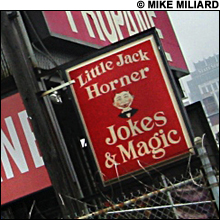 Observe the street, from time to time. . . .
Observe the street, from time to time. . . .
Note down what you can see. Anything worthy of note going on.
Do you know how to see what’s worthy of note? Is there anything that strikes you?
— Georges Perec, “Species of Spaces” (1974)
Endlessly photographed and gawked at from every angle, Boston is a city of clichés: the golden dome of the State House set into the skyline like a polished bauble; the Citgo sign looming behind the Green Monster; Trinity Church reflected in the stately blue of the Hancock Tower; The red-brick Freedom Trail snaking across the cobblestone beneath history’s shadows.

But there’s more to this town than picture-postcard banalities. Take a walk through the city and pay attention. Ferret out its obscure corners. Scrutinize the buildings that usually go unnoticed. It’s striking, the things that will catch your eye. The way the display of saintly statuary in the Downtown Crossing window of the Society for the Propagation of the Faith finds an analogue just a few blocks away in the Buddha figurines and Far Eastern gewgaws purveyed by Chinatown’s Oriental Fortune Giftland. Or the secret paths and stone stairways that crisscross Brookline, built back in the days when gypsies still camped in the fields of Corey Hill.
There are dozens of signs you’ve seen many times but never really thought about, like the gargantuan GILLETTE WORLD SHAVING HEADQUARTERS in Southie, which conjures images of row after row of shower-wet men, standing in front of mirrors with their faces lathered just so. And the signs you’ve never noticed, like the tiny plaque affixed to an Atlantic Avenue waterfront building — a humble commemoration in a city of grand memorials:
IN 1821 HERE ON THE SITE OF OLD RUSSIA WHARF
WILLIAM UNDERWOOD
“FATHER” OF THE AMERICAN CANNING INDUSTRY
ESTABLISHED HIS BUSINESS.
ERECTED BY THE
WM. UNDERWOOD COMPANY
THE NATION’S OLDEST CANNER
IN MEMORY OF HIS HISTORIC ROLE IN PIONEERING THE
PRESERVATION OF FOODS IN CANS
NOVEMBER 20, 1959
As it evolved over the past 375 years, Boston became a rich and varied palimpsest, enriched by each successive era’s distinctive stamp. Sometimes the city’s quirks are obscured by changing neighborhoods and city blocks; but sometimes they’re right in front of us, and we’re too busy charging blindly down the street to notice. For all the complaints that Boston is losing its character, there’s still a lot to this old, weird city. It’s just a matter of taking a closer look. Subway fares are going up again, so walk more and pay attention. See.